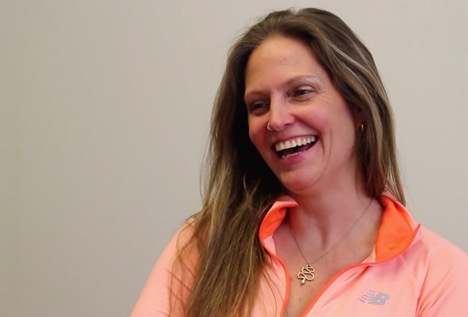Massachusetts native Elizabeth Garofalo drove “Guam Bombs” while stationed on the small island during her time in the Air Force.
“It was a $45 car rental, and you had it for a week. . . and maybe it would last a week,” said Garofalo, now a research assistant in the University of Massachusetts’ Center for Agriculture, Food and the Environment.
The 40-year-old UMass graduate student, who studies plant and soil sciences, now drives her own car, big enough for a family of five, to apple orchards and UMass’ Paige Laboratory.
“I graduated from high school and had a little bit of a several-year adventure,” she said.
Garofalo’s research with Stockbridge professor of plant pathology Daniel Cooley focuses on different types of bombs from her time in the Air Force: pests and diseases.
“During much of her program, she has also worked part-time for UMass Extension,” Cooley said, “helping farmers to manage insect and disease problems in crops using integrated pest management, an environmentally sound approach.”
Apple scab, a fungal disease that affects Malus trees — like apple trees — is one such bomb and poses a threat to apple trees across New England, according to the Integrated Pest Information Platform for Extension and Education.
“In some places, it’s called Black Lesion or Black Spot, which is a little sexier than scab,” Garofala said. “But we’re stuck with scab. It’s literally just like a scab on the fruit or the leaf caused by a fungus.”
The spread of disease among plants, especially food crops, can affect everyone from farmers to foodies and pie lovers.
“In a worst-case scenario, the trees can be completely defoliated, and eventually, you lose the orchard,” Garofalo said. “Of course, our commercial growers know better than to let it get to that point, so they manage it somewhat intensely throughout the primary part of the growing season.”
The primary growing season in New England is the current season, according to iPIPE.
However, it’s a variable window of time that depends on the weather and other environmental factors. The season’s start, though, can be observed by the first “green tip” and lasts until “petal fall,” according to Garofalo.
“As the green tissue on the trees start to come out of the buds, the spores that cause apple scab also become available to cause infection,” Garofalo said.
As an aspiring pathologist, Garofalo knows what to look for and how to prevent mass fruit crop destruction. Her nickname in Stockbridge, Hawkeye, is fitting for the non-traditional student, able to recognize when a tree is vulnerable to disease.
And it appears that the attentiveness required by motherhood, along with her years of life experience, contribute to her keen eye. Garofalo has an 11-year-old son and eight-year-old twin daughters.
“I found myself on this winding path with my kids and my husband,” she said. “While it has been a bit more difficult and it’s taken me longer, it means more, and I’m way more ambitious and way more motivated than I would have been as a 19-year-old student.”
Garofalo works with both Stockbridge and Extension, a program that involves field experts and whose purpose is to create and disseminate research to growers.
She continues efficiently on a winding path, garnering the respect of colleagues, professors and farmers along the way.
“She is a diligent, and very busy grad student, more than any other who has gone through my lab,” Cooley said. “She’s juggling a lot, but manages to keep it all in the air, most of the time with a smile.”
She refers to herself as a “Stockie for Life.” Although she will defend her thesis in the fall of 2018, it’s hardly the end of the road.
“My goal is to continue to work with Extension,” Garofalo said, “stay with the fruit team and maybe someday, I’ll get my Ph.D.”
Lyndsey A. Ware can be reached at [email protected].



















